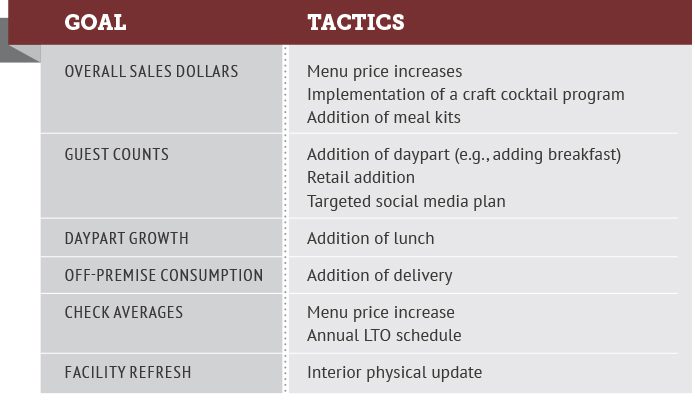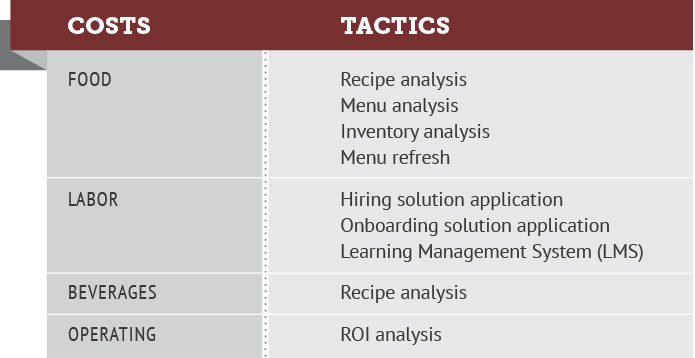The holidays are here. But no matter how busy you are, it’s time to start planning for success in 2018. Familiar impact areas—sales building, staffing, cost control/profitability—will remain vital in the year ahead. The pressure of increased costs and the battle for market share make documented, outcome-based annual planning essential.
Review your P&L
A profit and loss (P&L) analysis is a great start. You can use your internal accounting team or a third-party service. Just know what these pros tell you about profitability and performance is only one voice among many in creating an executable strategy.
Also, remember P&L analysis only tells you where you have been. So while it’s an essential first step, the key is involving your leaders to evaluate the how and, more importantly, the why that led to these results.
Add benchmarking
Benchmarking your performance is a solid next step. The National Restaurant Association can provide help evaluating your performance from several perspectives with its Restaurant Industry Operations Report. Based on operator data, this report can provide direction as you evaluate the P&L statement, organizing data points such as service type, check average and number of seats. Whatever performance factors you benchmark, think of them as guideposts on the journey—not the destination.
Start by defining sales goals
Your 2018 plan should start with your sales-building goals. Make sure to account for specific dollars and guest counts (on- and off-premise). Including guest counts ensures no “false positives” in sales growth from tactics like menu price increases. Remember the goal is true organic growth. Key goals for sales-building could include:
- Overall sales dollars.
- Guest counts.
- Daypart growth.
- Off-premise consumption growth: takeout, delivery, meal kits, portable retail.
- Check averages.
- Facility refresh.
Focus on realistic expectations and don’t over-project sales goals. Many tactics that succeed do so by taking market share from a competitor, not because they redefine the market. Consider the speed to which competitors can duplicate strategies.
Having multiple approaches to sales building is an advantage. The success of one or more tactics within each goal makes it easier to achieve the plan and promote growth. Simply put, multiple small successes will win the day in a mature industry like the restaurant business.
Create tactics that support goals
Ultimately, creating a monthly budget with sales goals will shape tactic development. The costs, time and return on tactics then must fit your profitability goals. Some tactics may support multiple growth opportunities. Here are some examples:

While considering growth goals, focus on quality over quantity. And don’t forget ongoing tactics such as menu changes and updates. Pick a few ideas that are likely to succeed. Solid execution always trumps volume. The litmus test should be, “If I employ this tactic, can I be best in class, differentiate my business and/or have solid growth in proportion to my investment?”
Any tactic carries hard and soft costs. The hard costs—people, product, marketing and materials—are often easier to recognize. Soft costs get underestimated. Training, process management (e.g., updating a POS system) and change management (e.g., how your teams or guests react to a new menu) can have a big impact on success because they involve change. When you and your leadership team look at changes, make sure you consider hard and soft costs.
Plan for staffing challenges
Staffing will likely continue to be a concern, so planning is a must. Set specific goals like reduced turnover or reduced labor costs with specific and realistic measures. Tactics to consider are the use of acquisition, onboarding, learning management systems and retention/motivation technology.
Of all areas that will directly impact sales building and profitability, staffing in the upcoming year may have the largest impact. An additional detailed plan here is the new standard.
The big picture on profitability
The end goal is to maintain cost measures that achieve profitability. As with all areas, an annual plan with attainable, measurable goals helps operators attain long-term success. Some key costs and tactics to manage/control profitability could include:

Write it out, make it real
Annual planning is not complete until it’s documented. Although the topics and process can be complex, simplicity in communication and execution is essential. When it’s written out, it’s more likely to be accomplished. Just keep the primary areas in mind:
- Be specific and measurable in goal-setting.
- Assign team members specific responsibilities.
- Provide transparency to all team members.
- Create teams to work on each goal.
- Define accountability.
In our dynamic industry with stiff competition from new competitors and increased costs, success will fall to those who plan well and execute in these key areas.



























